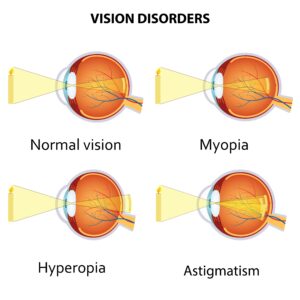Myopia
Myopia, or nearsightedness, occurs when the cornea is too steep and/or the eye is too long. This causes light to focus in front of the retina, resulting in blurry distance vision. Myopia is a common condition that affects nearly one-third of the U.S. population. The condition often worsens as the body grows, but it usually stabilizes in adulthood.
Hyperopia
Hyperopia, or farsightedness, occurs when light rays entering the eye are focused behind the retina, rather than directly on it. This may happen because the eyeball of a farsighted person is shorter than normal and/or the cornea is flatter than normal. Many children are born with hyperopia, and some outgrow it as the eyeball lengthens with normal growth.
Farsightedness is a fairly common vision problem. Initially, people with hyperopia can see distant objects very well but have difficulty seeing objects up close. Later in life, their distance vision deteriorates as the lens loses its ability to accommodate. Often this condition is not detected early in life because the young eye is able to compensate by altering the internal lens of the eye, called accommodation.
Sometimes people confuse hyperopia with presbyopia. Presbyopia is difficulty seeing near objects as a result of an age-related decrease in accommodation.
Astigmatism
Astigmatism occurs when the cornea is oblong—in other words, it is shaped more like a football than a basketball. The oblong shape causes light rays to focus in two places on the retina, causing blurred vision.
Astigmatism may also accompany nearsightedness or farsightedness and can get worse with age. A small amount of astigmatism may cause only slightly blurred vision. Sometimes uncorrected astigmatism can lead to headaches or eye strain.
Presbyopia
Presbyopia is the loss of accommodation over time. Accommodation is the eye’s natural ability to bring near objects into focus.
For those with good unaided distance vision, reading glasses are the simplest way to correct near vision. Those who also require distance correction often choose bifocals. For patients who would rather not wear glasses, multifocal contact lenses, refractive surgery, or recently FDA-approved eyedrops are also options.


